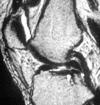Magnetic resonance imaging of anterior cruciate ligament rupture
- PMID: 15239843
- PMCID: PMC481075
- DOI: 10.1186/1471-2474-5-21
Magnetic resonance imaging of anterior cruciate ligament rupture
Abstract
Background: Magnetic resonance (MR) imaging is a useful diagnostic tool for the assessment of knee joint injury. Anterior cruciate ligament repair is a commonly performed orthopaedic procedure. This paper examines the concordance between MR imaging and arthroscopic findings.
Methods: Between February, 1996 and February, 1998, 48 patients who underwent magnetic resonance (MR) imaging of the knee were reported to have complete tears of the anterior cruciate ligament (ACL). Of the 48 patients, 36 were male, and 12 female. The average age was 27 years (range: 15 to 45). Operative reconstruction using a patellar bone-tendon-bone autograft was arranged for each patient, and an arthroscopic examination was performed to confirm the diagnosis immediately prior to reconstructive surgery.
Results: In 16 of the 48 patients, reconstructive surgery was cancelled when incomplete lesions were noted during arthroscopy, making reconstructive surgery unnecessary. The remaining 32 patients were found to have complete tears of the ACL, and therefore underwent reconstructive surgery. Using arthroscopy as an independent, reliable reference standard for ACL tear diagnosis, the reliability of MR imaging was evaluated. The true positive rate for complete ACL tear diagnosis with MR imaging was 67%, making the possibility of a false-positive report of "complete ACL tear" inevitable with MR imaging.
Conclusions: Since conservative treatment is sufficient for incomplete ACL tears, the decision to undertake ACL reconstruction should not be based on MR findings alone.
Figures
Similar articles
-
Three tesla magnetic resonance imaging of the anterior cruciate ligament of the knee: can we differentiate complete from partial tears?Skeletal Radiol. 2011 Jun;40(6):701-7. doi: 10.1007/s00256-010-1044-8. Epub 2010 Oct 8. Skeletal Radiol. 2011. PMID: 20931190
-
Partial tear of the anterior cruciate ligament of the knee: injury patterns on MR imaging.Knee Surg Sports Traumatol Arthrosc. 2012 Feb;20(2):256-61. doi: 10.1007/s00167-011-1617-7. Epub 2011 Jul 20. Knee Surg Sports Traumatol Arthrosc. 2012. PMID: 21773827
-
Magnetic resonance evaluation of remodeling process in patellar tendon graft.Clin Orthop Relat Res. 2004 Feb;(419):202-6. doi: 10.1097/00003086-200402000-00033. Clin Orthop Relat Res. 2004. PMID: 15021155
-
MR imaging of cruciate ligaments.Magn Reson Imaging Clin N Am. 2014 Nov;22(4):557-80. doi: 10.1016/j.mric.2014.07.003. Epub 2014 Aug 24. Magn Reson Imaging Clin N Am. 2014. PMID: 25442023 Review.
-
Imaging the anterior cruciate ligament.Orthop Clin North Am. 2002 Oct;33(4):663-74. doi: 10.1016/s0030-5898(02)00022-6. Orthop Clin North Am. 2002. PMID: 12528908 Review.
Cited by
-
Acute and chronic menisco-capsular separation in the young athlete: diagnosis, treatment and results in thirty seven consecutive patients.Int Orthop. 2015 May;39(5):967-74. doi: 10.1007/s00264-014-2657-7. Epub 2015 Jan 22. Int Orthop. 2015. PMID: 25603971
-
Three tesla magnetic resonance imaging of the anterior cruciate ligament of the knee: can we differentiate complete from partial tears?Skeletal Radiol. 2011 Jun;40(6):701-7. doi: 10.1007/s00256-010-1044-8. Epub 2010 Oct 8. Skeletal Radiol. 2011. PMID: 20931190
-
3-T MR imaging of partial ACL tears: a cadaver study.Knee Surg Sports Traumatol Arthrosc. 2007 Sep;15(9):1066-71. doi: 10.1007/s00167-007-0337-5. Epub 2007 May 12. Knee Surg Sports Traumatol Arthrosc. 2007. PMID: 17497130
-
Measuring the anterior cruciate ligament's footprints by three-dimensional magnetic resonance imaging.Knee Surg Sports Traumatol Arthrosc. 2012 May;20(5):986-95. doi: 10.1007/s00167-011-1690-y. Epub 2011 Oct 11. Knee Surg Sports Traumatol Arthrosc. 2012. PMID: 21987362
-
Diffusion-weighted imaging in musculoskeletal radiology-clinical applications and future directions.Quant Imaging Med Surg. 2015 Oct;5(5):740-53. doi: 10.3978/j.issn.2223-4292.2015.07.07. Quant Imaging Med Surg. 2015. PMID: 26682143 Free PMC article. Review.
References
-
- Boeree NR Watkinson AF, Ackroyd CE, Johnson C. Magnetic resonance imaging of meniscal and cruciate injuries of the knee. J Bone Joint Surg [Br] 1991;73-B:452–457. - PubMed
-
- Fischer SP Fox JM, Del Pizzo W, Friedman MJ, Snyder SJ, Ferkel RD. Accuracy of diagnoses from magnetic resonance imaging of the knee. J Bone Joint Surg [Am] 1991;73-A:2–10. - PubMed
-
- Jackson DW Jennings LD, Maywood RM, Berger PE. Magnetic resonance imaging of the knee. Am J Sports Med. 1988;16:29–38. - PubMed
-
- Liu SH Osti L, Henry M, Bocchi L. The diagnosis of acute tears of the anterior cruciate ligament: comparison of MRI, arthrometry and clinical examination. J Bone Joint Surg [Br] 1995;77B:586–588. - PubMed
Publication types
MeSH terms
LinkOut - more resources
Full Text Sources
Medical



